Pink Mold
Have you ever noticed some type of pink colored growth around your bathroom windows or shower? What about around your dishwasher seal?
If so, you could have pink mold growing around these areas.
This article is going to give you some information about pink mold, its risks, and how to properly remove it and prevent it from returning to your home.
Worried About Pink Mold? Get a Free Inspection!
Pink mold, though not a true mold, can be a hidden hazard in your home. It’s often found in damp areas like bathrooms and kitchens, posing health risks similar to other molds. Don’t let it go unchecked! Contact Mold Busters for a free virtual mold inspection. Our experts are ready to provide you with a comprehensive assessment and a plan to tackle any mold issue, ensuring your home is safe and healthy. Act now to protect your space!
What is pink mold?
Pink mold is not actually a “mold,” but a bacterial growth commonly found in damp areas of the home like the bathroom and kitchen. The two common types are Aureobasidium and Fusarium. These bacterial colonies can grow on many surfaces and locations which we will go into more depth later.
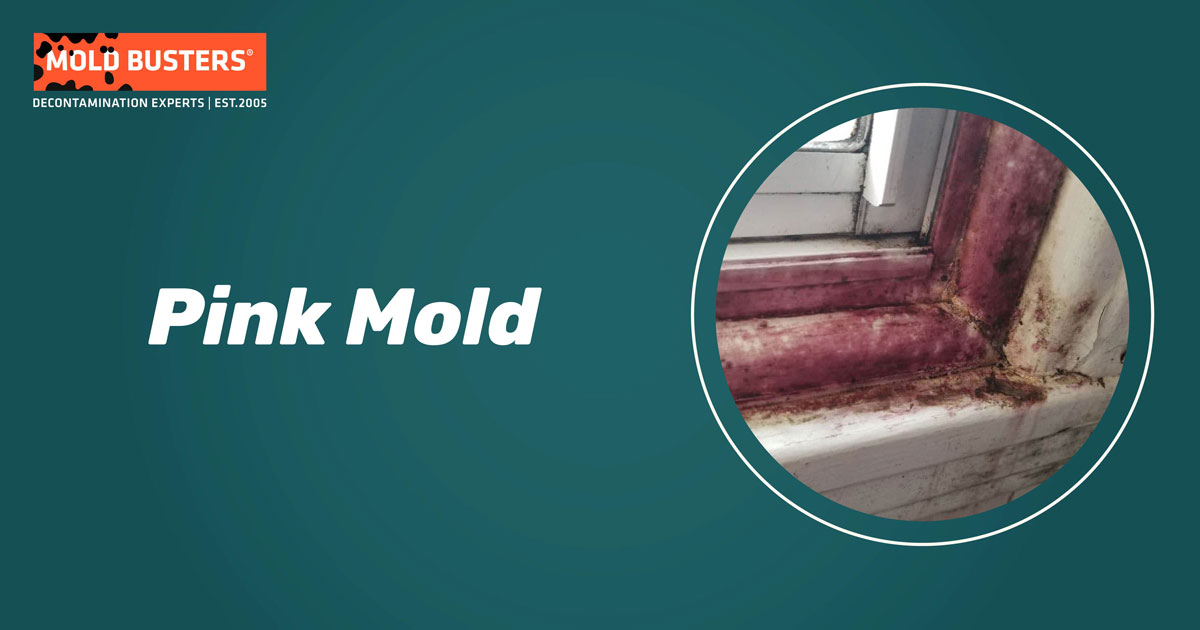
Other types of fungus that appear in pink color:
- Fuligo septica
- Epicoccum nigrum
- Aspergillus versicolor
- Penicillium
- Acremonium strictum
- Aureobasidium pullulans
- Phoma
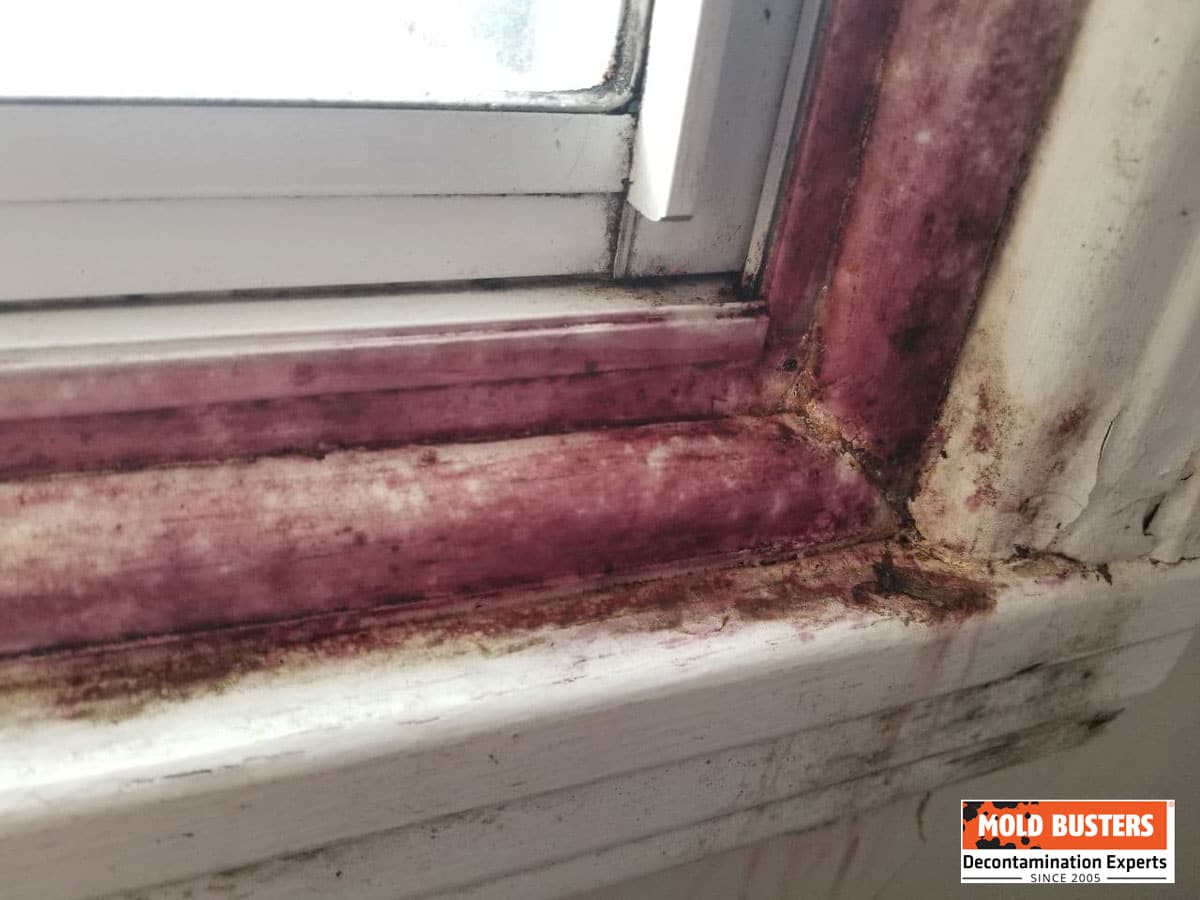
Just because it’s not technically a mold, does not mean you can just wipe it away and it’s gone. It acts very similar to a mold colony and will return if not remediated properly. It also poses many health risks that mimic various types of molds as well. These are just a few reasons why it’s classified as a mold.
What does pink mold look like?
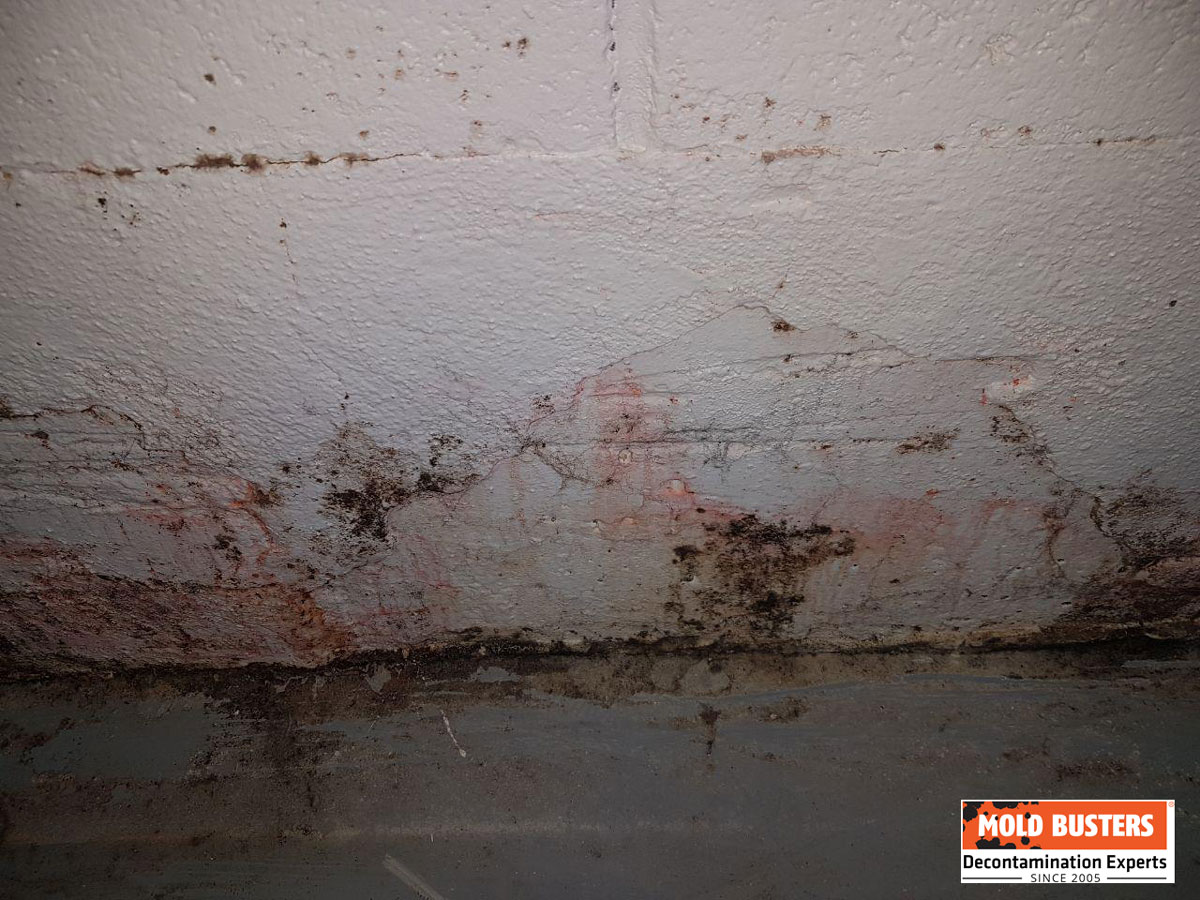
Pink mold can take on different shapes, colors, and “textures” as well. It can be light pink, dry, and fuzzy looking. Conversely, it can also take on a very slimy texture, a deep pink color, and very damp looking to the naked eye.
What does pink mold smell like?
Pink mold typically has a musty or mildew-like smell, similar to the scent of damp clothes or a wet basement. This smell is caused by the microbial volatile organic compounds (MVOCs) that mold produces as it grows. If you notice an unusual smell in your home, it could be a sign of a mold problem.
Pink slime mold
The pink slime mold, also known as Fuligo septica or Lycogala epidendrum, is found all over the world. They are most commonly found in moist shady places like wet leaves and logs. Falling rains wash spores off of the log into the surrounding ground to start new slime molds. The temperature can affect how large they grow or how quickly they reproduce. Pink slime molds are generally not poisonous but they do secrete digestive enzymes that can cause inflammation if eaten.
What are pink fuzzy mold and pink fluffy mold?
Pink fuzzy mold and pink fluffy mold are common descriptions for a type of mold that has a fuzzy or fluffy appearance due to the structure of its spores. This type of mold can appear on a variety of surfaces, including food, walls, and fabrics. It’s important to remove this mold promptly, as it can spread quickly and may cause health issues.
What is pink bacteria?
Pink bacteria, also known as Serratia marcescens, is often mistaken for pink mold due to its similar color. This bacterium is commonly found in bathrooms and other damp areas. While it’s not a mold, it can still cause health problems and should be addressed promptly. If you notice a pink substance in your home, contact a professional mold removal service for an accurate diagnosis and effective treatment.
What causes pink mold growth?
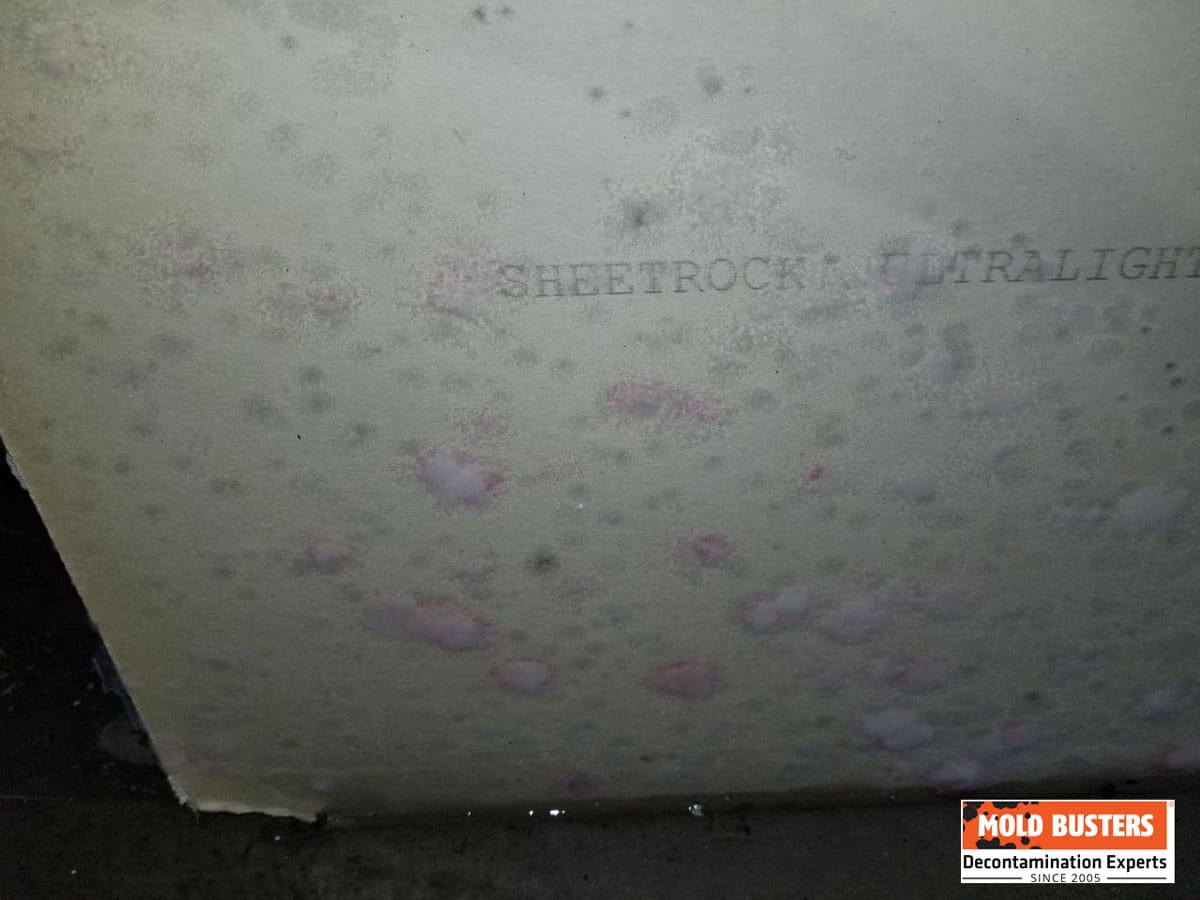
As with other types of molds, pink mold loves to colonize in damp, warm places. Also, keeping these areas in your home clean goes a long way to preventing molds of all species from growing.
Regular cleaning of showers, shower curtains, bathroom walls, windows, ledges, and floors will prevent mold from growing as you are removing one of the three conditions for mold to grow.
Mold needs a damp warm dark environment, as well as a food source. Take out one of the three conditions, heat, moisture, or foods, and mold will not spread or colonize.
Where can you find pink mold inside your home?
Pink mold likes all the places other molds like in order to grow. Bathrooms, kitchens, and basements are all ideal places for pink fungus to grow and spread.
| Type of Pink Mold | Characteristics | How to Deal with It |
|---|---|---|
| Pink Mold on Carpet | Often appears as spots or patches, can be fuzzy or slimy | Professional mold remediation is recommended |
| Pink Mold on Drywall | Appears as spots or patches, can cause discoloration and damage to the drywall | Professional mold remediation is recommended |
| Pink mold on clothes | Can cause discoloration and damage to the fabric, often appears as spots or patches | Wash the clothes in hot water with a mold-killing detergent |
| Pink Mold on Wood | Can cause discoloration and damage to the wood, often appears as spots or patches | Professional mold remediation is recommended |
| Pink Mold in Shower | Often appears in the corners, on the tiles, or on the shower curtain, can be slimy | Regular cleaning and proper ventilation can help prevent its growth |
Pink mold in bathrooms
Bathrooms are nice warm damp environments. Keeping them dryer by using proper ventilation when showering and removing standing water around showers and windows will help in preventing outbreaks. If you use a shower curtain, it will provide the proper conditions for pink mold growth as the soap scum and water left over from multiple showers will encourage growth. Keeping these items clean and dry after each shower will prevent mold growth from happening.
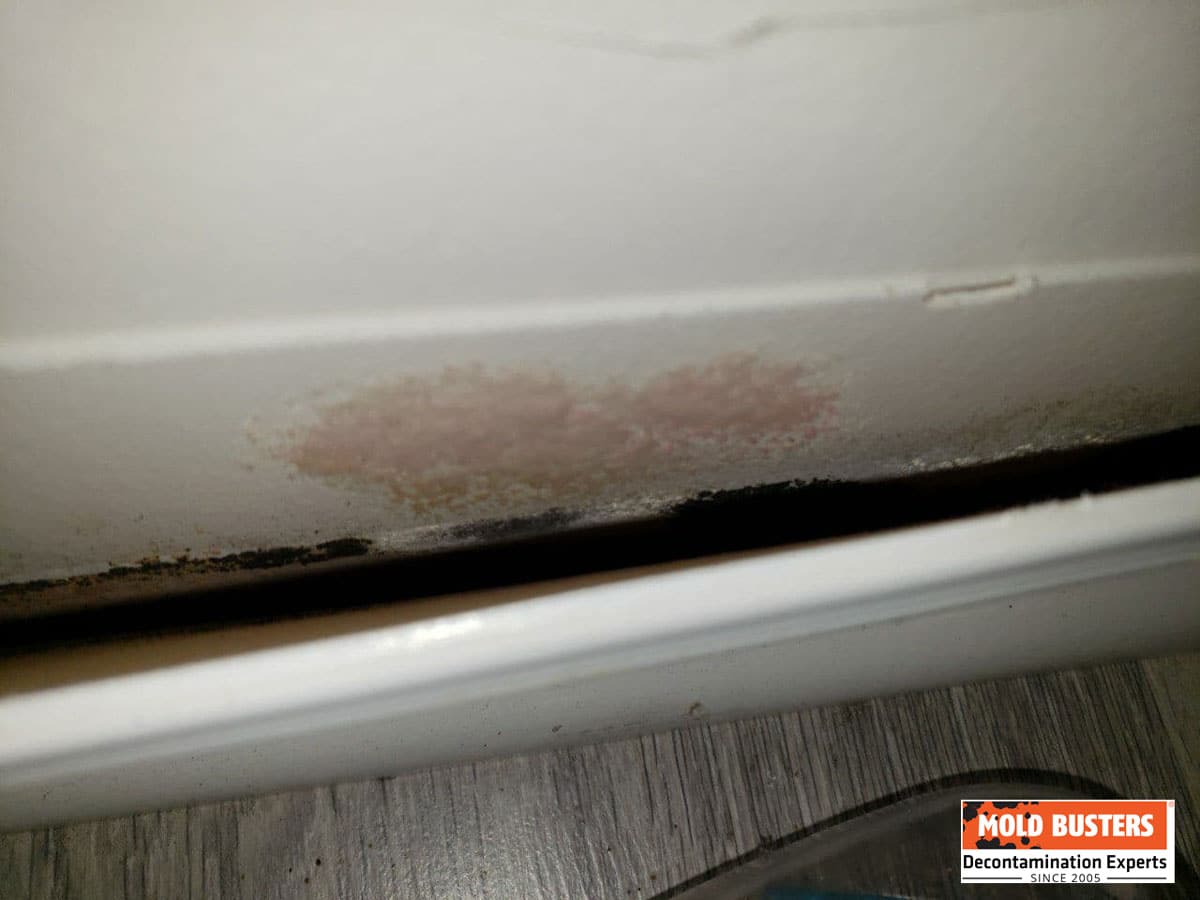
Pink mold in toilet
Around the toilet is another great place for pink mold to congregate. The toilet is naturally “dirty” and damp so mold will grow here quickly. It will gather under the toilet seat and under the toilet itself if there is water that gets underneath it somehow.
Pink mold in the kitchen (around sink and dishwasher)
In the kitchen, food that is left out uncovered, or around the sink and dishwashers are great places to grow mold because of the warm damp environments that are created. Food particles will get caught around the sink and dishwasher seals and mold will gather in these areas to feed on the leftover food.
To keep mold from growing in these areas, clean around the sink and the dishwasher regularly and it will prevent the mold from colonizing.
Mold growing on food is a regular occurrence. Food provides ample nutrients to grow mold and if it’s left out of the refrigerator it will be the correct temperature for proper growth to begin.
Pink mold in basements
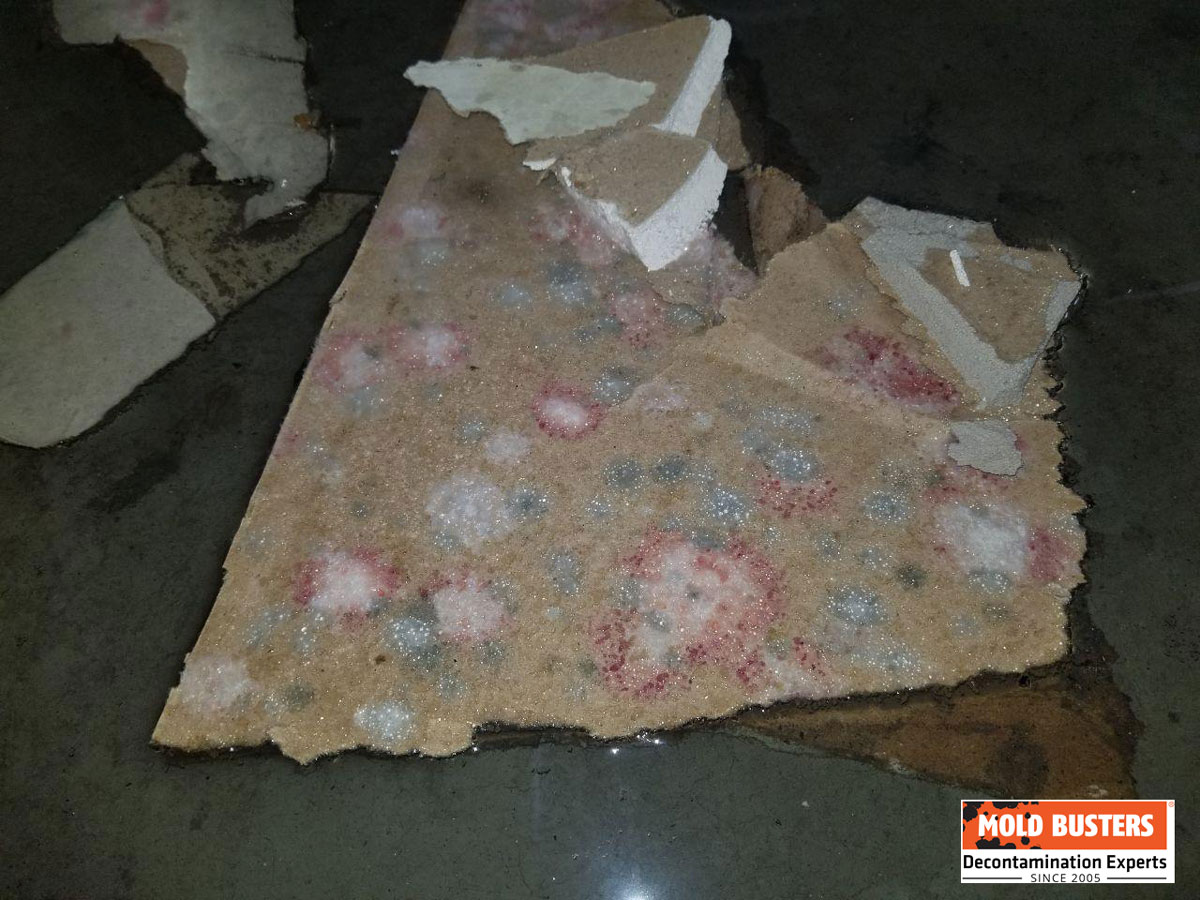
The basement areas of your home are naturally damp because of the exposed concrete and lower temperatures. Mold will grow there because most times, basements do not go through the same cleaning procedures as the living spaces in your home. They are usually just cleaned when they become very soiled.
If your home has a sump system, ensure your pump is working correctly and is pumping water to the outside of your home. Also, keep the areas around the sump clean from residue and dust.
Pink mold in a humidifier
Mold can grow in your humidifier if it is not cleaned regularly. The issue with mold in a humidifier is that it can release spores into the air and cause respiratory problems if you breathe them in. Mold also has a pungent smell which will linger in the room even after you clean the affected area. If your humidifier is showing signs of mold then it should be dried out or replaced.
Pink mold on clothes
Laundry rooms and closets are also great places for pink mold to grow. The damp washer area, the heat created from the dryer, and the detergent, as well as the dirt from soiled clothing, will provide everything a mold needs to grow.
The rules are the same when it comes to preventing mold in these areas. Keep the laundry room clean from dirt, food and dust. Keep the washer and dryer clean and dry when not in use. These procedures will make sure you prevent mold from growing in the laundry room or on the clothing that you are getting ready to clean or have just finished cleaning.
If you see any pink or any other color growths happening in your home, contact Mold Busters so they can send a fully trained professional to your location in order to confirm that you have mold and then set up a remediation plan to remove it properly.
Do not try to remove or clean the mold yourself as you can inadvertently spread it to other places in your home.
Pink mold on carpet: causes, risks, and remediation
Pink mold on carpets is a common issue, especially in areas prone to dampness or where water damage has occurred. This type of mold thrives in moist environments and can quickly spread if not addressed promptly. The risks associated with pink mold on carpets include respiratory issues, allergies, and in severe cases, infections. To remediate pink mold on carpets, it’s crucial to thoroughly dry the affected area, clean it with a mold-killing solution, and if the infestation is severe, consider professional mold remediation services. Preventing pink mold involves maintaining a dry and well-ventilated environment, promptly addressing any water damage, and regular carpet cleaning.
Pink mold on drywall: an unseen threat
Pink mold on drywall often goes unnoticed until it has significantly spread. This is particularly common in high-humidity areas such as bathrooms and basements. The health risks associated with pink mold on drywall include respiratory problems, skin rashes, and eye irritation. If you notice pink mold on your drywall, it’s important to act quickly. Remove the affected drywall, clean the area thoroughly with a mold-killing solution, and replace the drywall. To prevent pink mould, ensure your home is well-ventilated, promptly repair any leaks, and consider using mold-resistant drywall in high-humidity areas.
Pink mold on clothes: A hidden danger in your wardrobe
Pink mold can infest clothes that are left damp or stored in a humid environment. This not only damages the fabric but can also pose health risks such as skin irritation and respiratory issues. If you find pink mold on your clothes, wash them in hot water with a mold-killing laundry detergent. For severe infestations, it may be necessary to discard the affected clothes. Prevent pink mould by thoroughly drying clothes before storage and maintaining a dry, well-ventilated wardrobe.
Pink mold on wood: protecting your furniture
Pink mold on wood can cause significant damage over time, weakening the structure and ruining the appearance. This is particularly common in wooden furniture exposed to dampness or high humidity. Besides the damage to your furniture, pink mold on wood can cause health issues such as allergies and respiratory problems. If you notice pink mold on your wooden items, clean the surface with a mold-killing solution and dry it thoroughly. To prevent it, keep your wooden furniture dry, promptly address any water damage, and consider using a dehumidifier in high-humidity areas.
Showers, with their constant exposure to water and humidity, are prime locations for pink mold. This mold can cause a range of health issues, from minor irritations to serious infections. To clean pink mold in showers, use a mold-killing cleaning solution and scrub the area thoroughly. It’s also important to keep the shower dry when not in use and to regularly clean it to prevent mold growth.
Health risks of pink mold
While pink mold is less dangerous than black mold, it can still pose health risks, particularly for people with compromised immune systems. The bacteria that causes pink mold, Serratia marcescens, can lead to urinary tract infections, wound infections, and pneumonia, especially in hospital settings. Healthy people can also be affected if they have open wounds or sores that come into contact with the bacteria. Therefore, it’s important to address any mold issues promptly to protect the health of everyone in your home.
Can pink mold make you sick?
Exposure to pink mold can indeed make you sick, especially if you have a weak immune system or are allergic to mold. While pink mold is less harmful than some other types of mold, it can still cause a variety of health problems. These can range from respiratory issues, such as coughing and wheezing, to more serious conditions like pneumonia. If you suspect that you’re experiencing health issues due to exposure to pink mold, it’s important to seek medical attention promptly.
The following are all symptoms that can be traced to pink colored mold exposure.
- Respiratory issues (coughing, wheezing and respiratory tract infections)
- Allergic reactions (coughing, sneezing, itchy watery eyes, ears, and sinus troubles)
- Pneumonia and bronchitis
- Bladder and urinary tract infections
- Poisoning from eating tainted food
- Gastrointestinal issues (nausea, vomiting, upset stomach, and diarrhea)
The most common symptoms occur in young people, immunocompromised individuals, and the elderly. However, anyone can develop symptoms.
Is pink mold in shower dangerous?
While pink mold in showers is a common issue, it’s more dangerous than most people realize. Exposure to pink mold can cause symptoms such as coughing, wheezing, skin rashes, and eye irritation. In people with weakened immune systems or mold allergies, the symptoms can be more severe. If you or your family members are experiencing these symptoms and you’ve noticed pink mold in your shower, it’s important to seek professional help. A professional mold remediation service can safely remove the mold and provide guidance on how to prevent future infestations.
What happens if you eat pink mold?
Accidentally consuming pink mold can lead to food poisoning-like symptoms, including nausea, vomiting, diarrhea, and stomach cramps. In some cases, it can also cause allergic reactions or respiratory problems. If you suspect that you’ve eaten food contaminated with pink mold, it’s important to seek medical attention.
How to prevent pink mold from growing?
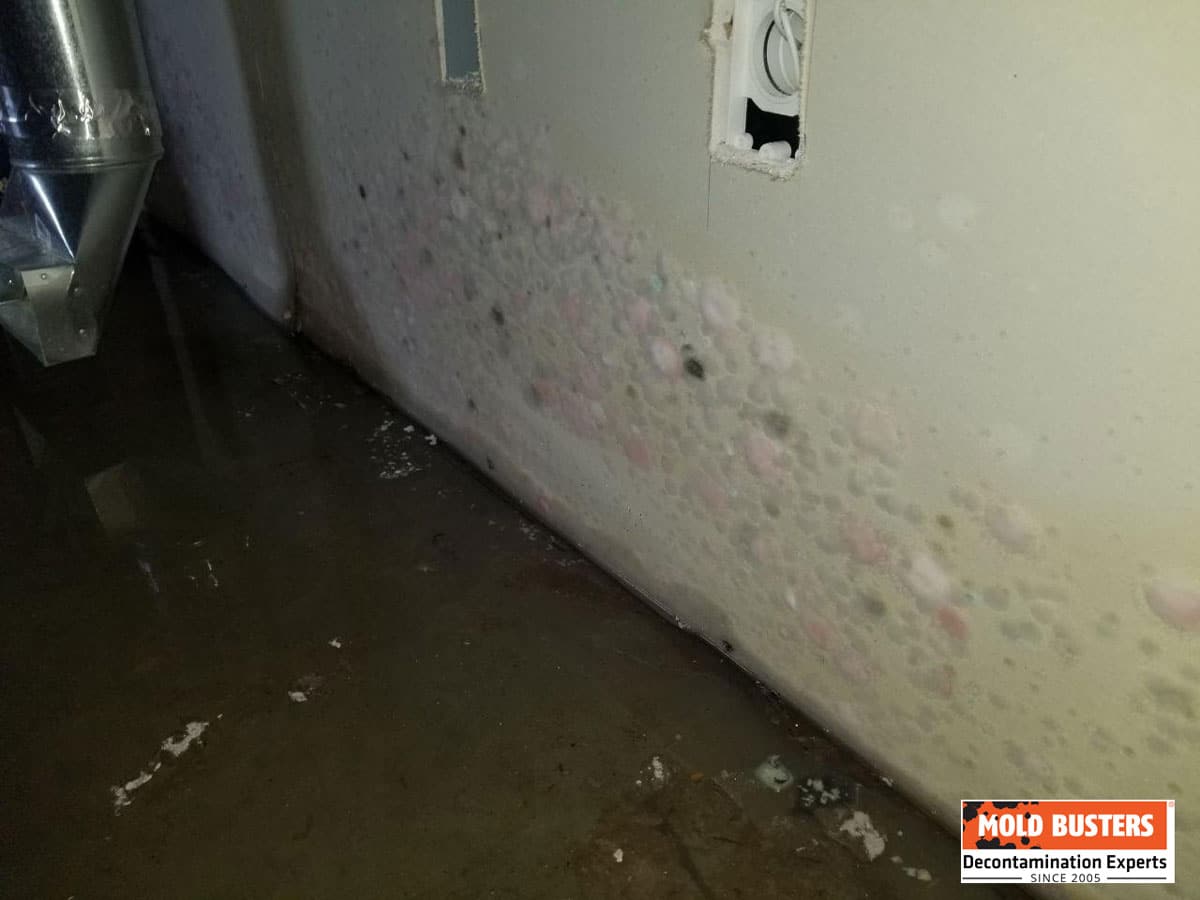
Preventing pink mold starts with addressing the root cause: excess moisture. Wet surfaces, particularly in bathrooms, provide the perfect breeding ground for mold. Here are some steps you can take to prevent pink mold:
- Maintain Dry Surfaces: After using the shower or sink, wipe down the wet surfaces with a clean towel. This removes excess water and helps prevent mold growth.
- Proper Ventilation: Ensure your bathroom is well-ventilated to reduce humidity levels. This can be achieved by using an exhaust fan or opening a window.
- Regular Cleaning: Regularly clean your bathroom with a solution of warm water and liquid dish soap. For stubborn mineral deposits or soap residue, a soft bristle brush can be used. Always remember to wear rubber gloves to protect your hands.
- Address Leaks: Leaks can lead to excess moisture and mold growth. If you notice any leaks in your bathroom, address them promptly.
If you have any doubts, contact a Mold Busters professional and they will give your home a full inspection and provide any recommendations that may be needed to correct for proper mold prevention.
For those who are unable to have a physical inspection, we also offer virtual inspection services. This is especially convenient for residents in Montreal and Ottawa where we have our locations.
How to get rid of pink mold?
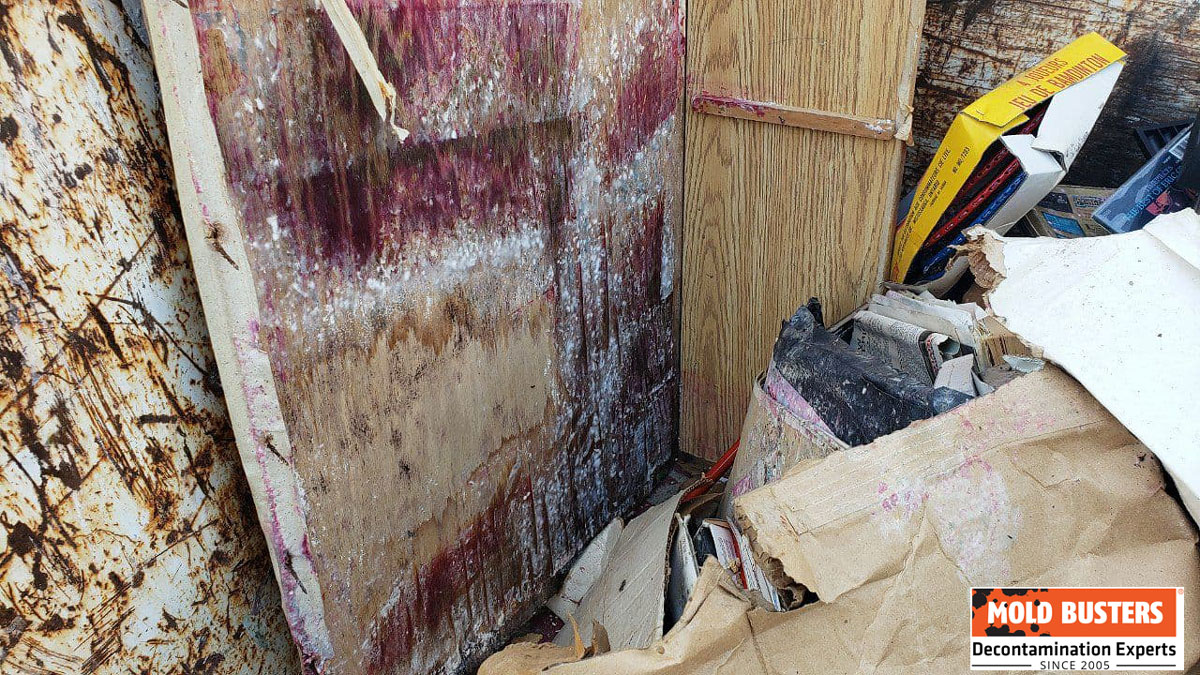
As with any mold type, removing and cleaning areas that have been infected with mold is best left to the professionals at Mold Busters. If you do not have the proper equipment or knowledge, you could spread mold to other areas of your home and make the situation worse.
Contact Mold Busters to have a fully trained professional visit and properly assess and remediate the mold growth. Doing this will ensure your home is safe and free of mold that could make your family ill.
Dealing with pink mold in the shower
If you notice pink mold on your shower walls, it’s important to act quickly. Here’s a step-by-step guide on how to remove mold from your shower:
- Prepare Your Cleaning Solution: In a small bowl, mix one part bleach with four parts water. You can also add a small amount of baking soda to the solution to help remove mold.
- Apply the Solution: Pour the solution into a spray bottle for easy application. Spray the solution onto the moldy areas and let it sit for about 15 minutes.
- Scrub the Area: Using a soft bristle brush, vigorously scrub the area to remove the mold. Apply some elbow grease to ensure you’re getting into all the nooks and crannies.
- Rinse and Dry: Rinse the area with warm water to remove the cleaning solution and any lingering bacteria. After rinsing, towel dry the area to remove any excess water.
Remember, if the mold problem is extensive or if you’re dealing with black mold, it’s best to call in professionals like Mold Busters.
Does vinegar kill pink mold?
Vinegar is a common household item that has numerous uses, one of which is its effectiveness in While some homeowners might resort to common household items like vinegar to tackle mold issues, it’s important to note that professional mold remediation is often the most effective solution. Vinegar might reduce some mold on the surface, but it doesn’t always eliminate the root of the problem. For a thorough and lasting solution, professional mold removal services are recommended.
Frequently asked questions
Can mold be pink?
Well, technically no. There is no pink mold, but rather a bacterial infestation that has very similar characteristics and reactions to mold. Pink colored mold reacts the same as fungal mold, so it’s classified as a mold strain when it’s dealt with by an inspection and remediation firm.
Is pink mold dangerous?
The simple answer is yes. Pink mold can be very dangerous. It is more dangerous to the very young, the elderly, and to people who are immunocompromised but can make anyone sick. The symptoms range from a runny nose and sneezing to poisoning which could include vomiting and diarrhea. If you think you have pink colored mold, or any other mold growing inside your home, contact Mold Busters right away.
How to clean pink mold off surfaces?
The proper way to clean pink mold off surfaces is to contact a professional at Mold Busters. They will visit your property, create a plan and properly remediate the affected areas so that your mold issues are resolved correctly.
If you have pink mold, any type of mold growth, or other contaminants in your home, contact Mold Busters right away to get an inspection and remediation plan in place to ensure your home is safe and healthy.
How to prevent pink mold in humidifiers?
In order to prevent pink mold from growing in your humidifier, you should make sure you use distilled water or a demineralization cartridge. You should also make sure the unit is covered and filled with the recommended level of water.

Get Special Gift: Industry-Standard Mold Removal Guidelines
Download the industry-standard guidelines that Mold Busters use in their own mold removal services, including news, tips and special offers:
Published: December 17, 2021 Updated: May 22, 2024

Written by:
Steven Adams
AMRT, WRT, ASD
Mold Busters
Fact checked by:
Michael Golubev
CEO
Mold Busters
